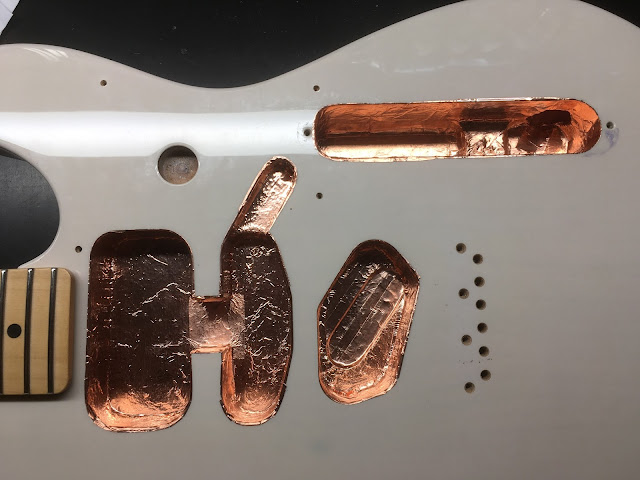1. Upgrade the volume and tone pots to Bourns 250K audio taper pots.
2. Copper shield the pickup and control cavities as well as the back of the pickguard.
3. Change the wiring for the switch selector as follows...
Before:
1. Bridge
2. Bridge + Middle
3. Middle
4. Neck + Middle
5. Neck
After
1. Bridge
2. Bridge + Middle
3. Bridge + Neck
4. Neck + Middle
5. Neck
So...here is the project...
The "Before" shot. Strings off and getting ready to take the guitar apart.
Time to break out the soldering iron. The control plate flipped over and some towels underneath to protect the finish in case I have an accident with the solder.
All wires from the switch and pots removed. As you can see, the guitar had conductive shielding paint in the cavities. A very nice touch...to bad it wasn't conductive. I put my meter against it and no continuity.
I started shielding the holes connecting the various separate cavities. I know...it was probably a bit overboard but I figured it was better to do it now when all the electronics was out of the way.
Here is the shot from the control cavity side.
Control cavity completely shielded. I shielded the hole for the output jack as well. Unfortunately, I went too far into the output jack and I'm not exactly sure what happened but after I completed the project, there was no sound coming from the guitar. There was a short somewhere and I traced it down to this section. I suspect that I wasn't able to flatten the copper shielding so it was coming into contact with the hot lead of the jack.
All cavities now shielded. I made sure to bring the shielding up over so that a bit of it was hanging over the edge. This way, when the shielded pickguard got installed, it would come into contact with the cavity shielding thereby providing a path to ground. By the way, I used copper tape that had conductive adhesive.
Here is a shot of the shielded pickguard in progress and completed. In the completed photo, you can clearly see the outline of the original shielding. It basically covers up just the pickup cavities. Because I was having the problem with the static noise when playing, I figured I'd have to shield the entire pickguard. My first attempt was to ground the original shield and that did NOT fix it. This solution, however, worked like a charm.
Time to start wiring...
I had pre-wired the control plate earlier. I forgot to take pictures as I went along so here is the finished product. Notice the switch is quite different from the original. This is an Oak-Grigsby 5-Way 2-Pole "Super-Switch" that I ordered from ToneShapers. The way I wanted the Telecaster wired couldn't be done with the original switch.
Here is the wiring diagram I used. Unfortunately, I found the image on Pintrest via a Google search so I don't know who drew up it up.
Here are closeups of the "Super-Switch" and the Bourns 250K Pots. By the way, those Bourns pots are really great. They have a very smooth action when turning. I found them to be superior to the CTS pots I pulled out of this guitar. I ordered the pots and the caps from Arrow Electronics.
Guitar all wired up and put back together.
All strung up and ready to go.
I also did a complete fret level and dress which I didn't bother to document. I posted a similar project in my "Dressing Some Frets" blog on that in 2016. Although the frets were in good shape, I felt that a level was in order and I also wanted to create a "fall-away" past the 12th fret. I know that isn't documented in the 2016 blog but there are lots of videos and information about how to do that online.
This was a very satisfying project to do. There is something oddly therapeutic about installing copper shielding...LoL. Anyway, the guitar is now completely shielded and although it probably didn't require it with noiseless pickups, I don't intend on keeping those pickups in there. I have a stock MiM Standard Telecaster that sounds fantastic. This one doesn't even come close. For whatever reason, I just don't like these Noiseless pickups. I had a Strat with them as well and I didn't like it then either. I ended up selling it. Just my personal preference. I've heard lots of people like these P-Ups.
Well...that wraps up this Blog. I must say the guitar plays really nicely. I just hope I can replicate that magical Tele sound with different pickups and still get a bit of that Strat quack in the 2 and 4 positions.




























